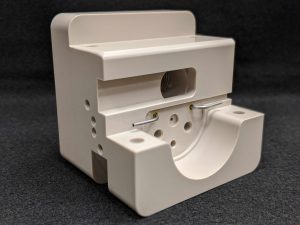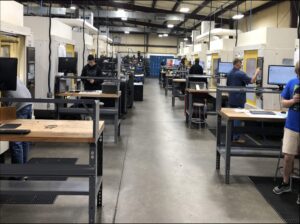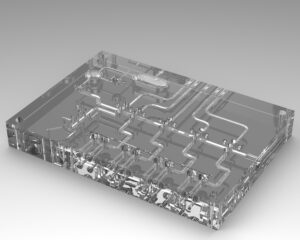It has been 45 years this November since British chemical manufacturing giant Imperial Chemical Industries (ICI) filed their patent for what is now one of the most adaptable and robust high-performance polymers in today’s international market. Entering the commercial sector as high-temperature cable insulation in 1980, polyetheretherketone (PEEK) has matured over the subsequent decades to perform numerous industry applications in automotive, aerospace, life sciences and more. Today, analysis from Mordor Intelligence valuates the global PEEK market size at .73 billion USD, with forecasts of 1.16 billion USD by 2029. What is it about PEEK that makes it so desirable? To answer that question, we’ll have to take a dive into the world of plastics engineering.
What is PEEK?
PEEK is a high-performance plastic (HPP) that boasts excellent resistance to chemical, mechanical and thermal stress. A member of the polyketone family, this polymer’s unique combination of physical properties makes it an indispensable commodity for industry innovators in search of complex engineering solutions. It comes as no surprise then that PEEK is employed for a wide range of environments from piping and gears to fluidic manifolds and medical prosthetics. Other HPPs may meet specific needs, but PEEK’s performance capabilities push the limits of what today’s polymers are capable of across the spectrum of environmental considerations.
PEEK Profile and Synthesis
PEEK is a high-performance thermoplastic with a semi-crystalline structure that displays an impressive balance of physical properties. It ranks among the highest HPPs regarding heat resistance and mechanical strength and has great chemical and radiation resistance as well. Polymer synthesis occurs from aromatic dihalides and bisphenolate salts by nucleophilic substitution. These salts form in situ from bisphenol and the addition of either sodium, alkali metal carbonate or hydroxide.
Heat Tolerance and Tensile Strength
PEEK’s melting temperature is 350°C (662°F), and depending upon curing cycle and formulation, it has one of two glass transition temperatures – 140°C (284°F) or 275°C (527°F). It has a continuous service temperature of 260°C (500°F), is highly resistant to thermal degradation, and is resistant to organic and aqueous environments as well. Within melting temperature range, PEEK can be processed via injection moulding or extrusion.
Its tensile strength is extraordinary at 170MPa (25,000 psi), and it has a Young’s modulus of 3.6 GPa.
Chemical Tolerance
PEEK’s chemical tolerance profile is quite good in many environments. It is resistant to alkalis, alcohols, greases, oils and both aromatic and halogenated hydrocarbons.
However, care should be taken when using PEEK materials to acidic environments, as performance is highly dependent upon the type of acid it is introduced to. It is highly susceptible to mineral acid environments, but withstands organic acids well. It is also resistant to certain aldehydes and ketones, though at higher temperatures, methylethy ketone will dissolve it.
Modern Engineering Solutions
Companies around the world recognize the potential PEEK represents for solving engineering challenges and in cost savings it brings to the table. In the automotive industry, gears and manifolds made from PEEK are sturdy, lightweight alternatives to metals and improve powertrain efficiency while reducing noise vibration. In electric vehicles, PEEK insulation takes up less space in e-motors, meaning more room for power and torque production.
In aerospace, some of its uses include rain erosion resistance in exterior parts and flame retardant material for internal components – all while cutting aircraft weight, resulting in reduced fuel costs and safer flights.
PEEK is no slouch either when it comes to life sciences, and medical sector industries are increasingly interested in its usefulness. Its chemical tolerances and the ease in which it can be machined makes it and other HPPs useful as fluidic components in dialysis and flow cytometry. Due to its FDA approval and radiolucency, PEEK is seeing increasing use in surgery as well, and some forms of PEEK are now replacing metals in knee replacements, spinal fusions and dentistry.
Innovative Engineering
PEEK’s combination of winning characteristics place it among the top HPPs today and makes it an optimal engineering choice for industries around the world. Tough, versatile, and lightweight, PEEK is a marvel that will continue to grow as a sought after engineering solution in the years to come. If your company is looking for modern solutions to engineering challenges, contact the experts at Piedmont CMG today.




